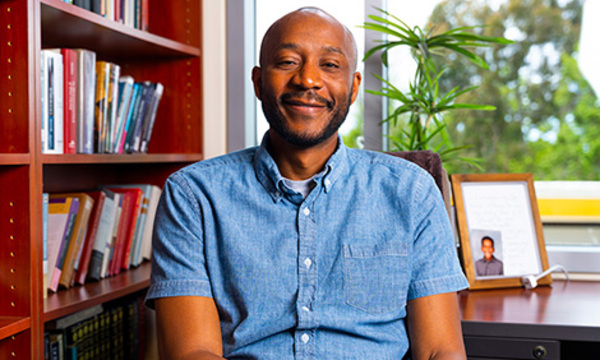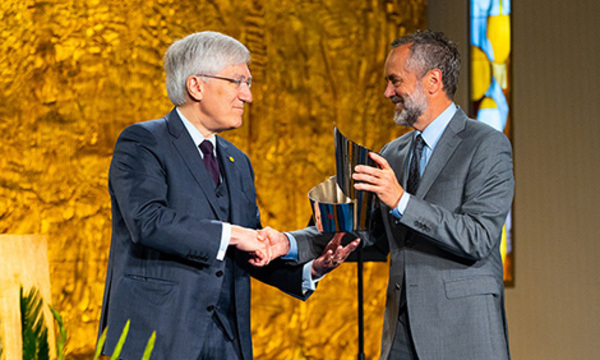Nelson, a lanky young Haitian man, brought his camera up to professor Tamara Welter and showed her the screen on the back. He needed help with an assignment. Such a complex machine, this was. His face was somber as she asked him if he understood why his photo was all very dark. As she explained, he nodded his head, then left to try again.
Nelson was part of an experiment, one that involved three Biola faculty members and two Biola students working in Haiti with a group of young English teachers enrolled in a new program for training visual journalists. Nelson was one of nine. With hard work, much patience and a drive to make visual storytelling theirs, he and his peers would become the first graduating class in a new certificate program.
A few minutes later Nelson was back, holding up the camera. Welter examined the screen on the back, glanced over the settings and exposure, then smiled.
“You got it!” she said.
Nelson’s face burst into a grin and he began jumping up and down as if on a pogo stick. Darting back to one of his classmates, he recounted the triumph, cradling the camera.
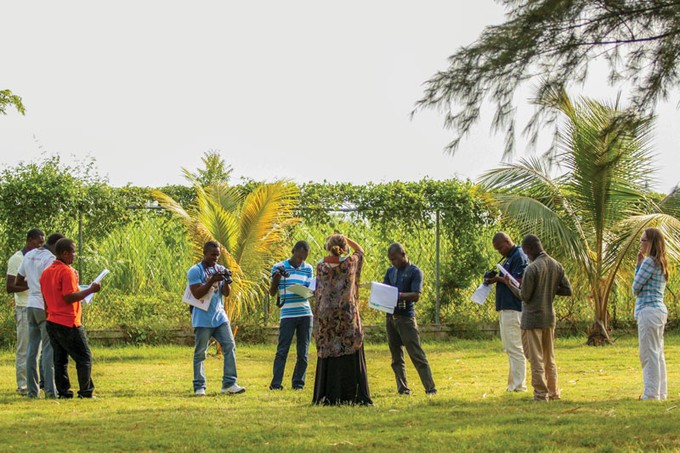
When spoken language is a barrier, teachers turn to other clues, other ways of knowing if they are getting through. Horace Mann once noted that Plato spoke less of schools and more about people willing to learn. And in Nelson’s face, his sparkling eyes, his sudden wide smile nearly laughing, his teachers had proof. He got more than just how to work a digital camera.
A photographer looks for eyes in the people seen through her viewfinder. For it is the eye, it is said, that is the window to the soul. And as educators in Haiti — coming from a land of much education and much economic hope — Welter and her colleagues were struck immediately by the eyes of their students, notably different from many of those along the streets and roadways as they’d traveled the roads through Haiti.
In Haiti, the eyes are often weary. There’s a kind of darkness in the averted gaze.
Part of it is distrust of you — yet another American — coming to look at them, seeking to help, not knowing how. Yet in some eyes, like Nelson’s, there is light: a joy that glistens and shines — a light from Christ within. It is with these students in Haiti (who are a part of the New Missions schools) that Biola University’s Department of Journalism and Integrated Media wants to be of help. For they know it is a vision of hope in Christ that will pave the way to a new century in this conflict-ridden land — Haitians helping Haitians to take steps forward in ways no one from the outside can take for them.
Building on seed money from a donor in Orange County, journalism and integrated media faculty members, assisted by their students, have begun a three-year venture to build a visual journalism program as part of New Missions, a nonprofit based in Orlando that runs Christian schools for 11,000 children and young adults all across Haiti. The donor responded to the tragedy of the 2010 earthquake with a desire to give to Haiti in a way that would go far beyond the dollars he contributed.
By the end of the three years, the goal is for the New Missions visual journalism curriculum and teaching program to begin to be self-sustaining. Teachers will be teaching students to become teachers in an ongoing cycle of visual journalism preparation. Each graduate who meets the curriculum’s requirements will earn a certificate of completion and have their work displayed in a gallery showing. The Biola team also hopes to be able to give each graduate a digital camera as the beginning of what, in time, could become a visual tool bag capable of earning them work with professional media organizations or with media staffs of nonprofits, ministries or missions organizations.
Yet this program is about so much more. John Dewey suggests, in Democracy and Education, that society “exists through a process of transmission,” but not merely of rote lessons. Rather, the best educators are about helping students grasp “ideals, hopes, expectations, standards, opinions.” They are about building confidence. And in this case, Biola’s faculty members are helping a small group of Haiti’s young people believe their stories have merit. And they do. Those stories are rooted in a culture that Haitians themselves are truly only able to fully understand. And their dreams for themselves and for their country come out of that understanding.
“My dream,” said one of the Haitian students, “is for Haiti to see every child, wherever they live — I want to see them go to school and to learn something just to help their family. This is my dream.”
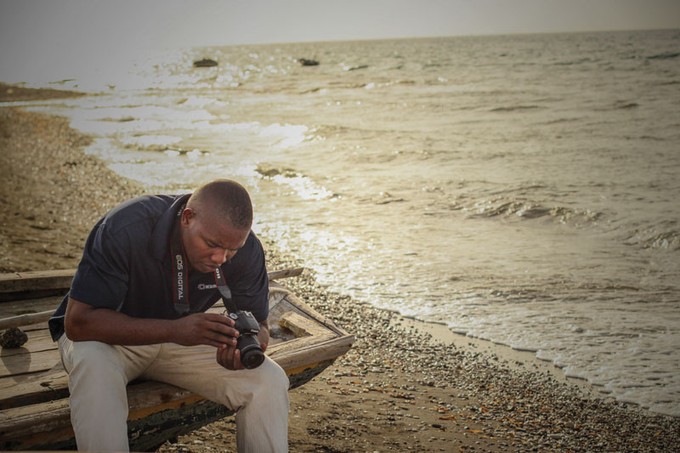
The visual journalism project in Haiti is one that builds on a global movement begun a decade ago now known as “Kids with Cameras.” It grew out of the experience of a photojournalist assigned to shoot photos of life in brothels in India; on a whim, she handed her camera to children on the streets of the city where she was working. The images those children created were astounding — evocative of an experience no one but a child in those circumstances could see. Those child-created photos became the internationally acclaimed documentary Born Into Brothels.
Professor Welter, inspired by the documentary, has taken Biola students to the Dominican Republic where Dominican teens were taught to apply their visual insights to a rough section of Santo Domingo, their own backyard. They gained new insight into themselves and what God could say through their visual stories. And Biola’s visual journalism students, sent to guide the learning, came back amazed at what God can do through the power of invested experience within another culture.
Welter has taken lead on the Haiti visual project as well, working with professor Michael Longinow and New Missions to lay out a slate of courses in journalism, photojournalism, media ethics and practical project work that will equip young adults to tell the visual stories of Haiti in ways that are unique to the worlds they navigate every day. Their eyes, guided by digital cameras, will capture still-frame stories and video stories in ways that will benefit nonprofit agencies and missions organizations, but also news organizations that often turn to local media when disaster hits a region. Sadly, Haiti’s place in the Caribbean makes it a likely victim of devastating hurricanes and, perhaps, more earthquakes. In coming semesters Welter, along with professors Longinow and Stewart Oleson and a series of select journalism and integrated media students, will travel to Haiti for one-week training sessions with a cohort of Haitian students. Professor Marla Campbell from Biola’s Cook School of Intercultural Studies has also joined the team to bring perspective to educating across cultural boundaries.
These students, graduates of the New Missions school district in Haiti, have conversational English skills (and possibly, for some of them, English teaching experience), and practical visual experience in photographing with point-and-shoot cameras for the New Missions organization. They carry an enthusiasm for learning that is inspiring to the Biola team. But their ambition runs far deeper than merely gaining a new set of skills and succeeding in a new career.
When Nelson was jumping with excitement over his captured image, perhaps his simple enthusiasm was also connected to his dream for Haiti itself.
“My dream for Haiti is to help the people to know some- thing better,” he said. “This is my dream for Haiti.”
Photos by Alissa Sandoval
Michael Longinow is a professor of journalism at Biola. Tamara Welter (Ph.D. ’14) is an associate professor of journalism and chair of Biola’s journalism and integrated media department.
 Biola University
Biola University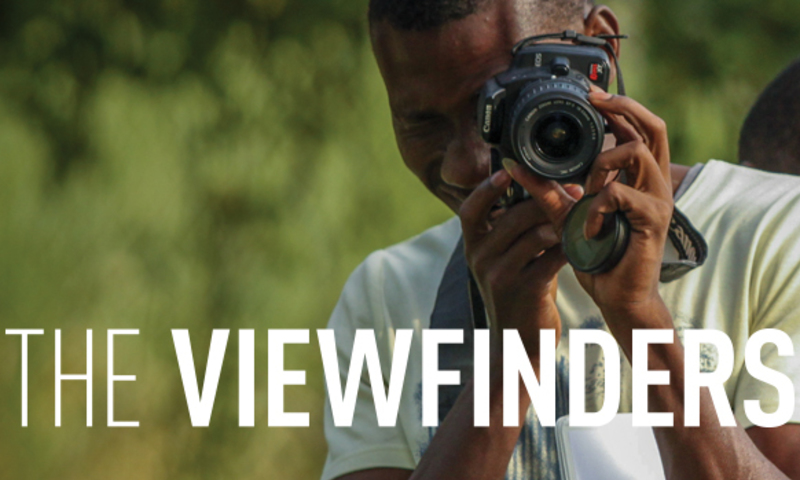

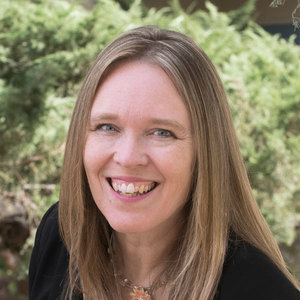
.jpg)
